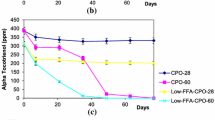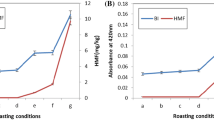Abstract
The quality of crude oil was examined as a function of the temperature and delay time between collecting and processing the fish byproducts from a commercial cannery into crude oil. Extracts from pollock byproducts stored at 6 and 15 °C for up to 4 and 10 days was examined. Longer storage of byproducts resulted in higher free fatty acid (FFA) and an increase in retinol levels in the extracted crude oils. Primary and secondary oxidation assays consisting of peroxide value and thiobarbituric acid-reactive substances increased initially with storage time on day 1 followed by an unexpected decrease with storage time. Higher storage temperature resulted in greater FFA and retinol levels, but lower oxidation products in the crude oils. The tocopherol levels decreased with storage time of the byproducts with no differences between the storage temperatures. Eicosapentaenoic acid, docosahexaenoic acid and polyunsaturated fatty acids percentage remained similar in the extracted oils with the respective storage time or temperature treatments.





Similar content being viewed by others
References
Newman WP, Middaugh JP, Propst MT, Roger DR (1993) Atherosclerosis in Alaska natives and non-natives. Lancet 341:1056–1057
Middaugh JP (1990) Cardiovascular deaths among Alaskan natives, 1980–1986. Am J Public Health 80:282–285
Shahidi F, Miraliakbari H (2004) Omega-3 (n-3) fatty acids in health and disease: part 1––cardiovascular disease and cancer. J Med Food 7:387–401
Morgan AF, Kimmel L, Davison HG (1939) Vitamin content of certain Pacific fish oils. J Food Sci 4:145–158
Food and Agriculture Organization (1992) Food and Agricultural Organization of the United Nations Yearbook, 71
Zhong Y, Madhujith T, Mahfouz N, Shahidi F (2007) Compositional characteristics of muscle and visceral oil from steelhead trout and their oxidative stability. Food Chem 104:602–608
Aidos I, Lourenco S, Van Der Padt A, Luten JB, Boom RM (2002) Stability of crude herring oil produced from fresh byproducts: influence of temperature during storage. J Food Sci 67:3314–3320
Wu TH, Bechtel PJ (2008) Salmon by-product storage and oil extraction. Food Chem 111:868–871
Oliveira ACM, Bechtel PJ (2005) Lipid composition of Alaska pink salmon (Oncorhynchus gorbuscha) and Alaska walleye pollock (Theragra chalcogramma) byproducts. J Aquat Food Prod Technol 14:73–91
Sathivel S, Prinyawiwatkul W, King JM, Grimm CC, Lloyd S (2003) Oil production from catfish viscera. J Am Oil Chem Soc 80:277–382
Bailey KM, Powers DM, Quattro JM, Villa G, Nishimura A, Traynor JJ, Walters G (1999) Population ecology and structural dynamics of walleye Pollock (Theragra chalcogramma). In: Loughlin TR, Ohtani K (eds) Dynamics of the Bering Sea: a summary of physical, chemical, and biological characteristics, and a synopsis of research on the Bering Sea. North Pacific Marine Science Organization (PICES), University of Alaska Sea Grant, AK-SG-99-03, Fairbanks, Alaska, pp 581–614
Carpo C, Paust B, Babbitt J (1993) Recoveries and yields from pacific fish and shellfish. Alaska Sea Grant College Program, Marine Advisory Bulletin no. 37
Butler CU (1949) U.S. fish and wildlife service. Fish Leaflet 126:3–6
Lytle JS, Lytle TF, Newmark HL, Deschner EE (1992) Stability of a commercially prepared fish oil (omega-3 fatty acid) laboratory rodent diet. Nutr Cancer 17:187–194
Nawar WW (1996) Lipids. In: Fennema OR (ed) Food chemistry. Marcel Dekker, New York, pp 225–319
Liston J, Stansby ME, Olcott HS (1963) Bacteriological and chemical basis for deteriorative cha. In: Stansby ME (ed) Industrial fishery technology. Reinhold, New York, pp 345–350
Koshio S, Ackman RG, Lall SP (1994) Effects of oxidized herring and canola oil diets on growth survival and flavour of Atlantic salmon, Salmon salar. J Agric Food Chem 42:1164–1169
Boran G, Karacam H, Boran M (2006) Changes in the quality of fish oil due to storage temperature and time. Food Chem 98:693–698
Aidos I, Masbernat-Martinez S, Luten JB, Boom RM, Van Der Padt A (2002) Composition and stability of herring oil recovered from sorted byproducts as compared to oil from mix byproducts. J Agric Food Chem 50:2818–2824
Saeed S, Howell NK (1999) High-performance liquid chromatography and spectroscopic studies on fish oil oxidation products extracted from frozen Atlantic mackerel. J Am Oil Chem Soc 76:391–397
Hung SS, Slinger SJ (1981) Studies of chemical methods for assessing oxidative quality and storage stability of feeding oils. J Am Oil Chem Soc 58:785–788
Bernardez M, Pastoriza L, Sampedro G, Herrera JJR, Cabo ML (2005) Modified method for the analysis of free fatty acids in fish. J Agric Food Chem 53:1903–1906
Shantha NC, Decker EA (1994) Rapid, sensitive, iron-based spectrophotometric methods for determination of peroxide values of food lipids. J AOAC Int 77:421–424
Siu GM, Draper HH (1978) A survey of the malonaldehyde content of retail meats and fish. J Food Sci 43:1147–1149
Heudi O, Trisconi MJ, Blake CJ (2004) Simultaneous quantification of vitamins A, D3 and E in fortified infant formulae by liquid chromatography-mass spectrometry. J Chromatogr A 1022:115–123
Bechtel PJ (2003) Properties of different fish processing by-products from pollock, cod and salmon. J Food Process Preserv 27:101–116
Bimbo AP (1998) Guidelines for characterizing food-grade fish oils Inform vol. 9, No. 5, Hertfordshire, UK
Sathivel S, Prinyawiwatkul W (2004) Adsorption of FFA in crude oil onto chitosan activated carbon, and activated earth: a kinetics study. J Am Oil Chem Soc 81:493–496
Hraš AR, Hadolin M, Knez Ž, Bauman D (2000) Comparison of antioxidative and synergistic effects of rosemary extract with α-tocopherol, ascorbyl palmitate and citric acid in sunflower oil. Food Chem 71:229–233
Aidos I, Van Der Padt A, Boom RM, Luten JB (2003) Quality of crude fish oil extracted from herring byproducts of varying states of freshness. J Food Sci 68:458–465
Aro TL, Larmo PS, Backman CH, Kallio HP, Tahvonen RL (2005) Fatty acids and fat-soluble vitamins in salted herring (Clupea harengus) products. J Agric Food Chem 53:1483–1488
Skara T, Sivertsvik M, Birkeland S (2004) Production of salmon oil from filleting byproducts-effects of storage conditions on the lipid oxidation and content of ω-3 polyunsaturated fatty acids. J Food Sci 69:417–421
Moren M, Naess T, Hamre K (2004) Conversion of β-carotene. canthaxanthin and astaxanthin to vitamin A in Atlantic halibut (Hippoglossus hippoglossus L.) juveniles. Fish Physiol Biochem 27:71–80
Schiedt K, Vecchi M, Glinz E (1986) Astaxanthin and its metabolites in wild rainbow-trout (Salmon gairdneri R). Com Biochem Physiol B 83:9–12
Kinsella JE (1987) Seafoods and fish oils in human health and disease. In: Kinsella JE (ed) Food science and technology, vol 23. Marcel Dekker, New York
Acknowledgments
We thank the University of Alaska Fairbanks, School of Fisheries and Ocean Sciences, Fishery Industrial Technology Center in Kodiak AK for providing processing facilities and Western Alaska Fisheries Inc. for providing pollock byproduct samples.
Author information
Authors and Affiliations
Corresponding author
About this article
Cite this article
Wu, T.H., Bechtel, P.J. Quality of Crude Oil Extracted from Aging Walleye Pollock (Theragra chalcogramma) Byproducts. J Am Oil Chem Soc 86, 903–908 (2009). https://doi.org/10.1007/s11746-009-1418-z
Received:
Revised:
Accepted:
Published:
Issue Date:
DOI: https://doi.org/10.1007/s11746-009-1418-z




